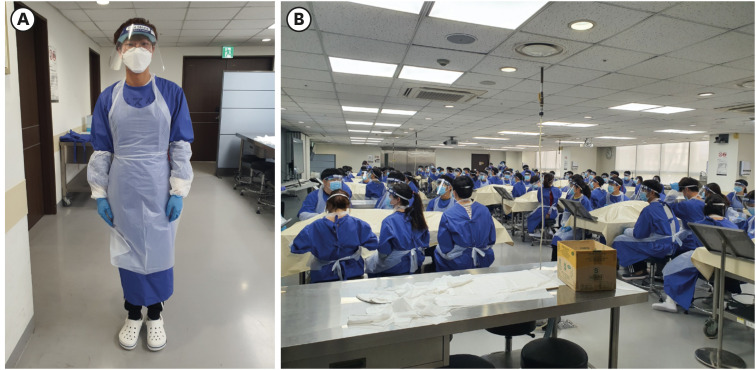J Korean Med Sci.
2021 Jul;36(26):e188. 10.3346/jkms.2021.36.e188.
Lessons from Cadaver Dissection during the COVID-19 Pandemic
- Affiliations
-
- 1Department of Anatomy, College of Medicine, Korea University, Seoul, Korea
- 2Department of Medical Education, College of Medicine, Korea University, Seoul, Korea
- 3Department of Biomedical Sciences, Brain Korea 21 FOUR, College of Medicine, Korea University, Seoul, Korea
- KMID: 2518316
- DOI: http://doi.org/10.3346/jkms.2021.36.e188
Abstract
- The rapid increase of the coronavirus disease 2019 pandemic from mid-February 2020 has led the anatomy department of the Korea University College of Medicine to cease the dissection laboratory. However, the hands-on anatomy laboratory experience is paramount to maximizing learning outcomes. In this paper, we share the experiences and lessons learned through the face-to-face cadaveric dissection experience during this disruptive situation. To minimize infection risks, the following strategies were applied: first, students' on-campus attendance was reduced; second, body temperatures and symptoms were checked before entering the laboratory, and personal protective equipment was provided to all participants; and third, a negative pressure air circulation system was used in the dissection room. We suggest that conducting face-to-face cadaveric anatomy dissection is feasible when the daily count of newly infected cases stabilizes, and there is ample provision of safety measures to facilitate hands-on education.
Keyword
Figure
Reference
-
1. Park SY, Kim YM, Yi S, Lee S, Na BJ, Kim CB, et al. Coronavirus disease outbreak in call center, South Korea. Emerg Infect Dis. 2020; 26(8):1666–1670. PMID: 32324530.
Article2. Chen S, Zhu J, Cheng C, Pan Z, Liu L, Du J, et al. Can virtual reality improve traditional anatomy education programmes? A mixed-methods study on the use of a 3D skull model. BMC Med Educ. 2020; 20(1):395. PMID: 33129310.
Article3. Iwanaga J, Loukas M, Dumont AS, Tubbs RS. A review of anatomy education during and after the COVID-19 pandemic: revisiting traditional and modern methods to achieve future innovation. Clin Anat. 2021; 34(1):108–114. PMID: 32681805.4. Peterson DC, Mlynarczyk GS. Analysis of traditional versus three-dimensional augmented curriculum on anatomical learning outcome measures. Anat Sci Educ. 2016; 9(6):529–536. PMID: 27078503.
Article5. McLachlan JC, Bligh J, Bradley P, Searle J. Teaching anatomy without cadavers. Med Educ. 2004; 38(4):418–424. PMID: 15025643.
Article6. Chang HJ, Kim HJ, Rhyu IJ, Lee YM, Uhm CS. Emotional experiences of medical students during cadaver dissection and the role of memorial ceremonies: a qualitative study. BMC Med Educ. 2018; 18(1):255. PMID: 30419880.
Article7. D Souza A, Kotian SR, Pandey AK, Rao P, Kalthur SG. Cadaver as a first teacher: a module to learn the ethics and values of cadaveric dissection. J Taibah Univ Med Sci. 2020; 15(2):94–101. PMID: 32368204.
Article8. Franchi T. The impact of the COVID\xe2\x80\x9019 pandemic on current anatomy education and future careers: a student's perspective. Anat Sci Educ. 2020; 13(3):312–315. PMID: 32301588.9. Pearson S. Anatomy: beyond the COVID-19 pandemic. Acad Med. 2020; 95(11):e1.
Article10. Ross CF, Pescitelli MJ, Smith HF, Williams JM. Teaching anatomy with dissection in the time of COVID-19 is essential and possible. Clin Anat. Forthcoming. 2020; DOI: 10.1002/ca.23640.
Article11. Harmon DJ, Attardi SM, Barremkala M, Bentley DC, Brown KM, Dennis JF, et al. An analysis of anatomy education before and during Covid-19: May-August 2020. Anat Sci Educ. 2021; 14(2):132–147. PMID: 33387389.
Article12. Böckers A, Claassen H, Haastert-Talini K, Westermann J. Teaching anatomy under COVID-19 conditions at German universities: recommendations of the teaching commission of the anatomical society. Ann Anat. 2021; 234:151669. PMID: 33400983.
Article13. Flynn W, Kumar N, Donovan R, Jones M, Vickerton P. Delivering online alternatives to the anatomy laboratory: early experience during the COVID-19 pandemic. Clin Anat. 2021; 34(5):757–765. PMID: 33470455.
- Full Text Links
- Actions
-
Cited
- CITED
-
- Close
- Share
- Similar articles
-
- Dividing Medical Students into Two Groups for Cadaver Lab under COVID-19 Situation
- The Management of Thyroid Disease in COVID-19 Pandemic
- Assessment and Management of Dysphagia during the COVID-19 Pandemic
- Tracheostomy in the Era of COVID-19 Pandemic
- The COVID-19 pandemic's impact on prostate cancer screening and diagnosis in Korea


